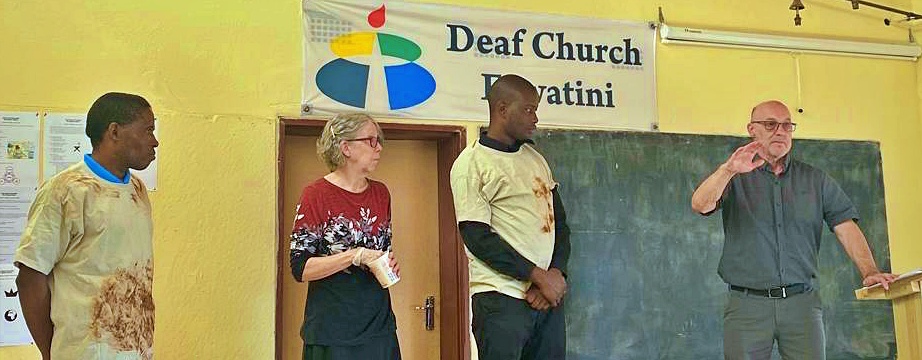
We had planned to go to eSwatini in May to encourage an American missionary couple and the Eswatini Deaf Church. Our aim was to teach leaders of the Deaf church how to present a summary of Romans 1-8, so they could use their skill in Swazi Sign Language to teach at the Deaf church and Deaf schools. When we could not go in May, we joined a team going in July. That team was composed of hearing Americans, Swazis, and South Africans, who would minister in both hearing and Deaf contexts (with some Deaf emaSwati joining us in the latter contexts). We weren’t sure anything would come of the material we had prepared to present in our baby Swazi Sign. We expected the rest of our team would spend several hours learning basic Swazi Sign and thought we might go over the material with leaders of the Deaf church then. So, we labored to communicate the gospel as presented in Romans 1-8. We made videos of the material and asked our Swazi Sign teacher and the American missionaries for input. Unlike us, they knew that Chuck was scheduled to preach at the Deaf church in Swazi Sign Language. They figured that was why we sent the videos. In eSwatini, we learned that Chuck was to preach in Swazi Sign Language. We prayed that God would magnify his strength through Chuck’s weakness.
Chuck spoke, from Romans 5, about the perfect righteousness of Christ, portrayed by a man from the church in a bright green shirt. A man with a clean tan T-shirt (over his Sunday clothes) portrayed Adam’s fall in sin. When he pantomimed eating the fruit, I smeared his clean T-shirt with mud. Chuck explained that he was using mud to portray the filthiness of sin.
Chuck communicated, from Romans 1, about those who do not know God or have his law, emphasizing that they are under God’s judgment. Every time Chuck explained the sins outlined in Romans 1, we smeared mud on the already dirty T-shirt worn by our Romans 1 portrayer. We unfurled the Romans 1 person’s long record of sin. Chuck communicated, from Romans 2, about those who say they know God and boast that they follow his law, yet sin. As we smeared mud on our Romans 2 portrayer, we covered the mud with foil and talked about how the people addressed in Romans 2 try to look good and cover their sin. “Two-faced!” a man sitting in the back of the church signed repeatedly. The Romans 2 portrayer also carried his long record of sin.
From the beginning of Romans 3, Chuck explained that all people—those who are like the pagans described in Romans 1 and those who are like the religious people described in Romans 2—are under God’s judgment. From the end of Romans 3, Chuck explained that those who believe in Jesus are declared righteous by God. Our dirty-shirted portrayers believed and changed into clean tan T-shirts. Their records of sin were put on Christ and they received Christ’s perfect record with no sin on it but covered with righteous attitudes and actions.
Chuck then explained Romans 4, which gives two examples of people who were declared righteous by God: Abraham and David.
To present Romans 6 visually, we had our actor—now clad in a clean tan T-shirt—show that, under his T-shirt, he also had the bright green T-shirt we had used to represent Christ. Chuck explained union with Christ, particularly focusing on Galatians 2:20 with specific applications such as “I, and my sin of anger, have been crucified with Christ. It is no longer I, and my sin of anger, that live, but Christ and his patience that live in me.”
To help Chuck explain the Romans 7 struggle with sin, we used a dirty sock to represent sin and had the dirty sock beckon to the multi-layered T-shirt wearer. The tempted man, who was both made new and joined with Jesus, then shone a flashlight (which was also tucked under his two T-shirts) to represent the Holy Spirit—the Helper who helps us obey. Chuck ended the sermon with his testimony, which is a powerful picture of Romans 1-8.
Sunday’s triumph was that, by God’s might and mercy, people were very engaged with the sermon. Any time Chuck struggled for the appropriate Swazi sign, the congregation pitched in to help, showing that they were tracking with the sermon.
The following Thursday was even more remarkable. Chuck and I were at a remote village with one of the missionaries and three Deaf men. The Deaf men were teaching sign language to hearing people in the village, so they could communicate with the isolated Deaf people who came to their hearing church.
After the lesson, the Deaf teachers came with us to a restaurant for lunch. One of the Deaf sign language teachers who had been at church Sunday asked an insightful question. He set up a Coke can to represent the Romans 1 person and clearly summarized Romans 1. He set up a glass to represent the Romans 2 person and clearly summarized Romans 2. He explained Romans 3 then asked, “Is Abraham like the Romans 1 person? Is David like the Romans 2 person?”
I was elated. In my early forays into the book of Romans, chapter 4 seemed like an aside. As I dug into the book, I merely thought of Abraham and David as examples of justification by faith: Abraham before he had obeyed and David despite his disobedience. I never connected the way Abraham specifically illustrated Romans 1 and David specifically illustrated Romans 2. I praise God that this man, who got the teaching through Chuck’s rudimentary Swazi Sign Language, took me deeper into Romans.